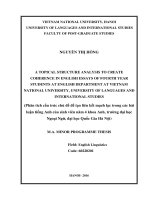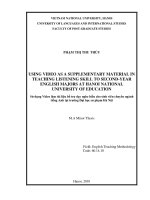Khóa luận tốt nghiệp motivation and attitude towards shadowing of third year english majors at vietnam national university of agriculture (khóa luận tốt nghiệp)
Bạn đang xem bản rút gọn của tài liệu. Xem và tải ngay bản đầy đủ của tài liệu tại đây (579.87 KB, 54 trang )
VIET NAM NATIONAL UNIVERSITY OF AGRICULTURE
FACULTY OF EDUCATION AND FOREIGN LANGUAGES
BA THESIS
MOTIVATION AND ATTITUDE TOWARDS
SHADOWING OF THIRD - YEAR ENGLISH MAJORS
AT VIETNAM NATIONAL UNIVERSITY OF
AGRICULTURE
ĐỘNG CƠ VÀ THÁI ĐỘ ĐỐI VỚI HOẠT ĐỘNG
SHADOWING CỦA SINH VIÊN NĂM BA
NGÀNH NGÔN NGỮ ANH TẠI HỌC VIỆN
NÔNG NGHIỆP VIỆT NAM
Student
: VŨ NGỌC MAI
Student code: 621199
Major
: ENGLISH
Supervisor : NGUYEN THI HOAI, M.A.
HaNoi – 2021
VIET NAM NATIONAL UNIVERSITY OF AGRICULTURE
FACULTY OF EDUCATION AND FOREIGN LANGUAGES
BA THESIS
MOTIVATION AND ATTITUDE TOWARDS
SHADOWING OF THIRD - YEAR ENGLISH MAJORS
AT VIETNAM NATIONAL UNIVERSITY OF
AGRICULTURE
ĐỘNG CƠ VÀ THÁI ĐỘ ĐỐI VỚI HOẠT ĐỘNG
SHADOWING CỦA SINH VIÊN NĂM BA
NGÀNH NGÔN NGỮ ANH TẠI HỌC VIỆN
NÔNG NGHIỆP VIỆT NAM
Student
: VŨ NGỌC MAI
Student code: 621199
Major
: ENGLISH
Supervisor : NGUYEN THI HOAI, M.A.
HaNoi – 2021
CERTIFICATE OF ORIGINALITY
I, the undersigned, hereby certify my authority of the study project report
entitled Motivation and attitude towards shadowing of third - year English
majors at Viet Nam National University of Agriculture submitted in partial
fulfillment of the requirements for the degree of Bachelor in English Language.
Except where the reference is indicated, no other person‘s work has been used
without due acknowledgement in the text of the thesis.
Hanoi, 2021
Vu Ngoc Mai
Approved by
SUPERVISOR
Nguyen Thi Hoai
(Signature and full name)
Date………………
i
ACKNOWLEGEMENT
First and foremost, I want to express my appreciation to my supervisor,
Mrs. Nguyen Thi Hoai, MA, for her invaluable advice, helpful ideas, and critical
remarks throughout my research, without which I would not have been able to
finish my research.
Next, I would like to send my sincere thanks to the lecturers in the Faculty
of Education and Foreign Languages at VNUA for their useful advice on this
study.
Finally, I would like to send my thanks to my family, who have created
the best conditions for me to study and practice. Similarly, I wish to send my
sincere thanks to all third-year English major students at VNUA for their
participation and assistance, without which this study could not have been
successful.
ii
TABLE OF CONTENTS
CERTIFICATE OF ORIGINALITY ..................................................................... i
ACKNOWLEGEMENT ....................................................................................... ii
TABLE OF CONTENTS ..................................................................................... iii
ABSTRACT .......................................................................................................... v
LIST OF ABBREVIATION ................................................................................ vi
LIST OF TABLES .............................................................................................. vii
LIST OF GRAPHS.............................................................................................. vii
Part 1: INTRODUCTION ................................................................................. 1
1.1. RATIONALE FOR THE STUDY ................................................................. 1
1.2. AIMS AND OBJECTIVES OF THE STUDY .............................................. 2
1.3. RESEARCH QUESTIONS ............................................................................ 3
1.4. SCOPE OF THE STUDY .............................................................................. 3
1.5. SIGNIFICANCE OF THE STUDY ............................................................... 3
1.6. DESIGN OF THE STUDY ............................................................................ 3
Chapter 1: LITERATURE REVIEW .............................................................. 5
1.1 REVIEW OF PREVIOUS STUDIES ............................................................. 5
1.2 THEORETICAL BACKGROUND ................................................................ 7
1.2.1. Motivation ................................................................................................... 7
1.2.2. Attitude ...................................................................................................... 11
1.2.3. Shadowing ................................................................................................. 14
Chapter 2: METHODOLOGY ........................................................................ 20
2.1. RESEARCH METHODOLOGY ................................................................. 20
2.2. RESEARCH CONTEXT ............................................................................. 20
2.3. DATA COLLECTION................................................................................ 21
2.3.1 Data collecting instruments ........................................................................ 21
2.3.2 Data collecting procedures: ........................................................................ 22
iii
2.4. DATA ANALYSIS ...................................................................................... 22
2.5. SUMMARY METHODOLOGY ................................................................. 23
Chapter 3: FINDING AND DISCUSSION ..................................................... 24
3.1. RESEARCH QUESTION 1: ........................................................................ 24
3.1.1. Motivation ................................................................................................. 24
3.1.2. Attitude ...................................................................................................... 27
3.1.3. Suggestion ................................................................................................. 29
3.2 SUMMARY OF FINDINGS AND DISCUSSION ...................................... 32
Part 3: CONCLUSION ..................................................................................... 33
1.Recapitulation................................................................................................... 33
2. Concluding remarks ........................................................................................ 33
3. Limitation of the study .................................................................................... 33
4. Recommendations/Suggestions for further study ........................................... 34
REFERENCES .................................................................................................. 35
APPENDIX ........................................................................................................ 38
iv
ABSTRACT
The aim of this study was to investigate the attitudes and motivations
towards shadowing of third-year English majored‘ students at Viet Nam
National University of Agriculture Specifically, the researcher wanted to
examine the participants' attitudes/motivations towards shadowing and some
suggestions for the shadowing activities that was compulsory to the course of
Phonetics and Phonology in their study program. This study addresses questions
two research questions: (1) What are learners' attitude/motivation towards
shadowing? (2) What are some suggestions for shadowing activities Participants
of the study are 96 third - year English majors at VNUA. They were asked to
complete a survey consisting of 30 items. The study used mixed approaches,
quantitative and qualitative approaches. The results indicated that the majority
of participants found shadowing to be effective for learning English. Students'
motivation towards shadowing included that content comprehension of
shadowing materials is the key factor in order to improve the item scores of
Phonetics and Phonology in their study program. In other words, it is crucial to
take content into consideration in order to encourage participants to continue
shadowing in the future. The participants suggested that the difficulty level of
shadowing materials and audio speed need to match the participants‘ level so
that they can maintain high accuracy in their shadowing performance.
Keywords: English, Shadowing, Motivation, Attitudes
v
LIST OF ABBREVIATION
VNUA
: Vietnam National University of Agriculture
EM
: Extrinsic motivation
IM
: Intrinsic motivation (Watanabe et al. 2013)
Ct
: Cost
Pf
: Attitude towards shadowing performance
St
: Satisfaction
vi
LIST OF TABLES
Table 1: Examples of shadowing varieties (Kadota and Tamai, 2004; Lambert,
1992; Murphey, 2001; Norman, 1976). .............................................................. 14
Table 2: Participants of the study ........................................................................ 20
Table 3: Gender ................................................................................................... 21
Table 4: English proficiency levels ..................................................................... 21
Table 3.1: Motivation towards shadowing .......................................................... 24
Table 3.2: Attitudes towards shadowing ............................................................. 27
LIST OF GRAPHS
Figure 1: A Taxonomy of Human Motivation, adopted from Ryan and Deci
(2000) .................................................................................................................... 8
vii
Part 1: INTRODUCTION
1.1. RATIONALE FOR THE STUDY
In Second Language Acquisition, a teaching technique called 'shadowing'
is increasingly recognized as an effective practice for developing skills in
English classes. Shadowing has been considered by language researchers to be
one of the most correct and effective ways of thinking in the brain for language
learning. Shadowing refers to the task of auditory monitoring of the
simultaneous repetition of a native voice heard through a set of headphones
(Lambert,1992).
Shadowing helps students learn in the right direction and effectively,
creating a habit of arranging learning and practice time each day, improving
their ability to communicate quickly in the learning process. Besides, it is a
more practical professional practice method. This study focuses on motivations
and attitudes of students in the process of Shadowing practice as well as their
experiences.
The biggest advantage of "shadowing" (immediately repeating each word
the learner hears) is to help feel the fullest and the way up and down
(intonation), the rhythm and especially the speed of native speakers. Being
familiar with the above factors will help learners tend to become more fluent
and confident when speaking in English or any other foreign language in the
future. Shadowing is supposed to help learners improve their bottom-up
phonetics quickly in a relatively short amount of time, so those of lower levels
who are not fully exposed in the classroom will enjoy its benefits.
According to Markee's (1992) on innovation in language teaching,
frequent shadowing machines will likely cause resistance in applying shadowing
methods outside of Japan, the quality of teaching. Mostly due to the difference
with the teaching method of formal communication languages of L2 pedagogy,
the creative language output of learners is mainly emphasized (Hamada, 2015).
1
Besides, the acoustical aspect of Shadowing practice can also lead to learner
anxiety, such as fear of speaking, anxiety during testing, and fear of being
judged by the Shadowing standard that requires the learner to emit his voice
speak exactly the same as in model sounds, in front of an audience in class
(Horwitz,1986).
Shadowing is an exercise in interpreter training programs, but according
to Torikai (1997) he says that Shadowing has some positive aspects for English
learners. This thoroughly study how shadowing can contribute to the language
learning field by examining an English classroom where students practice
shadowing. After three months of practice, students responded to a
questionnaire. The results showed that more than 80% of the students thought
their English skills improved through shadowing exercise and considered it an
effective exercise. It also helps to boost their motivation and to participate more
actively in the classroom.
Currently, third-year English majors at Vietnam National University of
Agriculture have taken the course named ―English phonetics and Phonology‖ in
which shadowing is a mandatory task. Some students‘ performances are
excellent while others seem to have difficulties finishing the task. Moreover,
from the best of my knowledge, most students do not have much experience
with shadowing before taking this course. Therefore, in this study, I would like
to investigate the motivation and attitude towards shadowing of third - year
English majors at Vietnam National University of Agriculture (VNUA).
1.2. AIMS AND OBJECTIVES OF THE STUDY
This study aims to investigate the attitude and motivation towards
shadowing of third-year English majors at VNUA. Specifically, the researcher
would like to examine participants‘ attitude/motivation towards shadowing, and
some suggestions for shadowing activities.
2
1.3. RESEARCH QUESTIONS
1. What are learners' attitude/motivation towards shadowing?
2. What are some suggestions for shadowing activities?
1.4. SCOPE OF THE STUDY
The subjects of the study are 3rd year English majors at VNUA. The number
of K63 students is 121, the time of doing research is from February 17, 2021 to June
30, 2021.
There is also very little research focusing on psychological attitudes in
shadowing practice. Shadowing practice in this study is limited to the
compulsory activity in the course Phonetics and Phonology in the students‘
study program.
1.5. SIGNIFICANCE OF THE STUDY
The data provided will provide teachers with information about the
effectiveness of shadowing practice in Phonetics and Phonology courses.
Teachers could understand students‘ experience with shadowing practice in the
course, i.e., their attitude and motivation, on the basis of which appropriate
changes could be made for more efficient use of shadowing practice for the
Phonetics and Phonology course in particular and in learning English in general.
This study would be useful to make shadowing a more effective technique for
teaching and learning English at the Faculty of Education and Foreign
Languages in particular and at VNUA in general. Students will be more aware
of the value of the shadowing practice, not only in the course of Phonetics and
Phonology, but also for their proficiency improvement. Also, results from this
study will be useful for students because they can learn from other students who
have practice shadowing well.
1.6. DESIGN OF THE STUDY
Statement of thesis originality:
Certificate of originality
3
Abstracts:
List of abbreviations, graphs, tables, and figures
This research is divided into three primary parts:
Part I: Introduction presents rationale for the study, Aims and objectives
of the study, Research questions, Scope of the study, Significance and Design of
the study.
Part II: The rest of the study consists of 3 parts as follows:
Chapter 1: Literature review, the researcher investigates prior literature
to clarify some major terms in the study.
Chapter 2: Methodology, the justifications for the use of the
methodology with detailed descriptions are presented.
Chapter 3: Findings and discussion, the researcher processes the data
acquired to answer the research questions.
Part III: Conclusion - this part will summarize the main issues that have
been addressed in the study, points out the limitations, draws pedagogical
implications concerning the research topic.
References:
Appendix:
4
Chapter 1: LITERATURE REVIEW
1.1 REVIEW OF PREVIOUS STUDIES
Sumiyoshi and Stagnant (2017) examine motivation and attitudes towards
the learner's Japanese as a foreign language. This study explores the
psychological factors of the student, from the perspective, regarding the practice
of shadowing in English.
The results indicated that the majority of participants found shadowing to
be effective for both listening and speaking skills, and agreed on the usefulness
of the feedback. However, individual differences are found in how they
prioritize glossiness in relation to their ability to understand the content. The
implications of the applications in the classroom are also discussed.
Shadowing is becoming more widely acknowledged as an excellent
exercise for improving listening skills. Shadowing is an auditory tracking
activity that involves the simultaneous repeating of heard native speech through
a set of headphones (Lambert, 1992), It was originally utilized as a training
method for simultaneous interpreters since it necessitates a high level of
proficiency in both listening and speaking skills at the same time This act of
simultaneous hearing and speaking is not only unique to shadowing, but it also
occurs often in our daily lives in the form of inner voice, or sub-vocalization, in
the phonological loop of working memory in the brain (Baddeley, 1992).
Tamai (1997) re-defined Lambert's definition of shadowing as a training
technique of listening in which the learner attempts to repeat the incoming
information simultaneously as exactly as possible while listening attentively to
the heard speech. Tamai was the pioneer of research in Japan's English as a
foreign language (EFL) context. Tamai (1992) found a statistical significance
that shadowing was more effective than dictation. There has been a rise in the
popularity of shadowing practice since the study was published. The impact of
shadowing is linked to working memory stimulus during the attempt of online
5
brain function (simultaneous listening and speaking), which promotes
automatization of bottom-up speech recognition (Kadota, 2007, 2012).
However, Kadota claims that it is a highly cognitive activity that, when
used as a pedagogical tool in language classroom education, demands careful
attention by practitioners. Because this context is mainly dependent on the
grammar-translation technique and is a memorization-centered educational
culture, the mechanical quality of shadowing practice has been regarded as
appropriate to the context (Sasaki, 2007). Furthermore, the audiolingual element
of shadowing practice can induce anxiety in learners, such as speech
apprehension, academic stress, and fear of poor assessment, because shadowing
demands learners to output speech in exactly the same manner as in the model
audio, in front of a classroom audience (Horwitz, 1986).
Students should be able to use shadowing methods to assist them to
pronounce words correctly and practice their accuracy and fluency while reading
aloud, as well as their oral abilities. Students may use the shadowing method to
assist them to overcome their difficulties pronouncing a word. According to
Geoffrey (2003), pronunciation is concerned with two connected skills:
recognition or comprehending the flow of speech and production or fluency in
the spoken language. When English serves as an international language or lingua
franca, it may be found in a variety of nations and is produced in a variety of
accents or dialects. People might be classified as native or non-native. In terms
of pronunciation, for example, depending on whatever model is used, the word
"Document" might be pronounced differently. They can say /'dɒk.jə.mənt/ if
they're speaking British English or /'dɑː.kjə.mənt/ if they're speaking American
English. In terms of pronunciation, for example, depending on whatever model
is used, the word "Document" might be pronounced differently. They can say
/'dɒk.jə.mənt/ if they're speaking British English or /'dɑː.kjə.mənt/ if they're
speaking American English.
6
According to Torikai (2003), shadowing can also help people concentrate
better. She claims that most listening exercises are passive and lack
concentration, whereas shadowing requires learners to focus intensely on
listening to and reproducing the message in order to follow the speech. Torikai
claims that shadowing can improve memory capacity, which leads to better
listening. The acquisition of communicative competence is the most essential
component for language learners nowadays (Mext, 2003). Despite the fact that it
is critical, most students do not get the chance to speak in English and are not
taught activities to help them build communication skills. Because shadowing
necessitates multi-tasking, it may be used to improve communication skills.
Today, shadowing is seen to be a powerful and effective activity that
should be included in each English language program. According to Tanaka
(2004), shadowing necessitates reproducing the heard speech in a short amount
of time. She claims that this activity highlights the pupils' listening abilities
(input skills), understanding skills, and reproducing skills (output skills).
Shadowing will not be successful if one or more of the abilities are lacking.
Shadowing is a useful activity for assessing the current learner's intake,
understanding, and output abilities. Students are more likely to enhance their
English abilities by shadowing, which focuses on listening, comprehending, and
speaking at the same time.
1.2 THEORETICAL BACKGROUND
1.2.1. Motivation
Motivation is of vital importance in language learning. It is widely
accepted that motivated learners are more likely to achieve learning than those
who are not.
When building external factors for integrated dynamics, Deci et al. (1991)
proposes a theory of self-determination, involving a process that promotes
internalization, through a continuum from the outside towards internal
7
motivation (pp. 328–330). The main focus is on building external dynamics in
four categories, based on the relationship between external factors and the
degree of self-determination.
Figure 1: A Taxonomy of Human Motivation, adopted from Ryan and Deci
(2000)
The figure above presents a visual continuum of self-determination
theory, arranged from left to right, from non-self-determination to most selfdetermination, to the extent to which individuals are motivated in behavior. The
far left is the newly added type, the driving force, which is the lack of intention
to act (Ryan and Deci 2000). Amotivation arises when students are unmotivated,
which can happen for a variety of reasons. Sometimes the student has no feeling
of ability and does not believe he is capable of learning in the appropriate
manner. Other times, the students do not grasp the link between the needed
activities and the desired conclusion. Trainers may help in these situations by
gently building self-esteem
In the middle block is extrinsic motivation which is defined by Arnold
and Brown (1999) as "the desire to obtain a reward or avoid punishment; the
attention is on something other than the learning process itself" (p.14). Extrinsic
motivation remains essential, particularly in school and the job. Not every
activity is pleasant for everyone, and not everyone can be enthusiastic about the
8
same subject at the same time. As a result, in the lack of intrinsic drive, we rely
on extrinsic incentives to complete tasks which is split into four sections:
External regulation, Introjection, identification, Integration.
External regulation, the least self-determined form of extrinsic motivation.
People are driven by external regulation as a result of an active influence from
outside. When a person engages in an activity in order to receive an outside
given reward, her conduct is said to be externally controlled. (Elaine Anderson
2017) For example, if a person attends a science fair in order to win a restaurant
gift voucher, she is not behaving out of personal interest, but rather out of a
desire to get the prize.
Introjection is the result of an internalized, pressing voice motivating you.
Guilt, anxiety, or humiliation are all sources of motivation for certain behaviors.
Introjected regulation motivates a person to perform in a certain way not
because he wants to, but because he feels obligated to. An example, A student
who spends a lot of time studying violin for a performance feels that if she
doesn't do well, she won't be able to play properly, and others will judge her.
The term "identification" refers to a person's conscious value of a goal and
belief that the action is personally meaningful. The individual is also not
motivated by guilt or shame; instead, she sees that some behaviors are
advantageous to her growth and embraces them. A student who is studying
really hard for the IELTS exam because getting into college is essential to him is
an example. Getting into college is a goal that you set for yourself. Despite
being extrinsically driven, the conduct is nonetheless largely independent.
Integration, which is similar to intrinsic motivation but not for enjoyment
or for interest (Sumiyoshi and Svetanant) For example, a person may have
investigated the cause and determined that it is compatible with their own beliefs
and requirements. The activity becomes self-initiated after that. It is selfcontained and unaffected by external factors. Integrated motivation, although
9
being extrinsic, contains many of the same characteristics as intrinsic drive and
is the best kind of extrinsic motivation. Integrated regulation is even referred to
as intrinsic by some academics since the person has totally absorbed the
extrinsic reason into their beliefs.
Extrinsic motivation is a type of motivation that comes from outside of
oneself. Extrinsically motivated behaviors, in a contrast to intrinsically driven
behaviors, are acts taken to attain a specific goal, such as earning a reward or
avoiding a punishment. This sort of drive does not always imply a lack of selfcontrol in the activities that are carried out (Vallerand 2003). Extrinsic
motivation (EM) can be characterized along a continuum, depending on the
amount to which it is internalized into the self-concept, according to Herman,
Deci, and Ryan (1985; Vallerand, 1997).
The far-right end is intrinsic motivation when the learner is intrinsically
interested in and likes the activity. Intrinsic and extrinsic motivations are
essentially distinct in that they cannot be transformed into one another (Ryan
and Deci 2000). This intrinsic motivation, which is similar to Gardner's
integrative motivation, is the primary motivator for learning; however, intrinsic
motivation is more universal than integrative motivation because it is concerned
with the target language itself rather than the community in which the language
is used. Intrinsic motivation is defined as conduct motivated by internal rewards.
In other words, motivation to engage in activity comes from within the
individual since it is inherently pleasant to them. Extrinsic motivation, on the
other hand, includes participating in an activity in order to gain external benefits
or avoid punishment. (Amy Morin, LCSW). Several studies have shown that
eliminating anxiety from the classroom is critical. Worry, according to Oxford
(1999), can demotivate pupils, although Csikszentmihalyi (1996) believes that
"unnecessary risk to the students' ego" (p.84) should be avoided.
10
Vallerand (1997) constructs and proposes a three-part intrinsic motivation
taxonomy (Watanabe, Oba, Sugiyama, Nohara, & Sakuta 2013): IM-Knowledge
refers to the feelings of attempting to master the task or accomplish the goal;
IM-Accomplishments refers to the feelings of striving to master the task or
achieve the goal, and IM-Stimulation refers to pleasant sensations or enjoyment
while doing the work.
1.2.2. Attitude
Despite significant swings in popularity, social psychologists have been
doing attitude research since the 1920s, and this study has undergone substantial
theoretical and empirical changes since then. Edwards (1999) considers perception
to be the most ubiquitous issue in modern social psychology. Attitudes have been
defined from many perspectives based on various ideas, resulting in semantic
disputes and discrepancies about the generality and specificity of the word. For the
purpose of this research, the recommended working definition of an attitude is "a
summary of ideas" (Bohner and Wanke 2002).
A specific issue with the definition of attitude is the overlap with other
terms in social psychology such as 'belief, opinion, value, habit, trait, motive,
and ideology. Shaw and Wright (1967) proved, on the other hand, that it is
feasible to discriminate between attitudes and related words. Precise
explanations of relevant terms are likely to aid the researcher in his or her
efforts.
Beliefs are cognitive in origin, and while they can cause and be caused by
emotional reactions, they account for just one component of attitude. There is a
contrast between descriptive views, which comprise observations or
assumptions about the world, such as that a vegetarian diet is basically healthful,
and prescriptive beliefs, which include must or should statements. Opinions are
overt beliefs that may be verbalized, whereas attitudes might be latent and
transmitted through both verbal and nonverbal processes. Furthermore, attitudes
11
include emotive reactions but views do not (Baker 1992). Values (Schwartz
2007) may be thought of as higher goals that people try to accomplish. Because
they transcend specific acts and contexts, values are seen to be more abstract
than attitudes. Attitudes can only be predictors of behavior (Bohner and Wanke).
Habits are believed to be essentially behavioral patterns. Whereas both motives
and attitudes are latent dispositions, that is, they are expressed in observable
reactions, motives are goal-specific while attitudes are simply object-specific.
Ajzen (1988) distinguishes attitudes from personality characteristics. Although
both words are supposed to relate to latent structures, attitude responses are seen
to be evaluative, whereas characteristics are understood to represent inclinations
to behave in certain ways and are not focused on any specific external objective.
In comparison to attitudes, traits are seen to be more stable, lasting, and resistant
to change. Ideology refers to a patterned naturalized collection of beliefs and
values connected with a specific social or cultural group (Garrett).
A person's general approach to events, ideas, people, or other objects is
characterized as their attitude, especially when that approach persists over time.
The consequence of a person's judgment of the attitude object is his or her
attitude. Attitude is made up of three components: affective, feelings and
emotions about the attitude object; behavioral, the behavior one exhibits when
faced with the object; and cognitive, the thoughts and beliefs one has about the
object (Christianlly Cena, 2021).
The ABC model, often known as the tripartite model of attitude, divides
attitudes into three parts. Attitude is made up of three parts:
Affective Attitude refers to how we feel about a situation.
What we do about something is referred to as behavioral attitude.
How we think about something is referred to as cognitive attitude.
12
This approach identifies and deconstructs attitudes to reveal what's going
on underneath the surface. Affect can sometimes have a greater impact on
conduct than cognition.
An attitude's affective component pertains to how people feel about
something. First reaction, and might be positive or negative, such as a fear or
excitement-based emotion. It's critical to distinguish between effect and
cognition, where effect refers to how feel and cognition refer to how to think.
Deep-seated memories or experiences that form our sentiments about things may
drive our emotional reactions. The emotional component of an attitude refers to
a judgment or positive/negative appraisal of an item, person, task, or brand. The
word "affection" is an excellent approach to recall this component, but keep in
mind that the viewer might be positive or negative (Ford, 1991)
Intentions, or what we would do, are the behavioral component of an
attitude. Our attitude or cognition can influence it. The behavioral component,
on the other hand, is widely thought to be changeable. The ‗cognitive'
component frequently influences behavior (La Piere,1934).
What we think about things is our cognitive component. It‘s what happens
when we pause and really think hard about it. Cognitive and affective
components are interrelated but don‘t always overlap (Chris Drew,2020). For
example, we may believe that taking a vacation is a poor decision, even though
we have favorable sentiments about it, since it is too costly. That's because we're
suppressing our irrational feelings in order to make rational judgments.
Since the 1990s, the ABC model has largely gone out of favor in social
psychology since it is commonly accepted that conduct should not be conflated
with attitude. Perhaps they should be treated as different entities (Sutton &
Douglas, 2020, p. 151)
13
1.2.3. Shadowing
Defined by Lambert (1992), shadowing involves monitoring the tempo of
a parrot-heard speech, word-for-word repetition of a piece of information in a
language, through headphones. Originally, Shadowing was a technique used by
cognitive psychologists and neuropsychologists and used as a method to
improve concurrent interpretation skills. Dr. Arguelles' shadowing technique is
carried out in a specific way. This technique also has a lot of variations, as can
be summarized in the table below:
Table 1: Examples of shadowing varieties (Kadota and Tamai, 2004; Lambert,
1992; Murphey, 2001; Norman, 1976).
Name
Procedure
Complete
Learner‘s shadow everything speakers say
shadowing
Selective
Learners select only certain words and phrases to shadow
shadowing
Parallel reading
Learners shadow while reading the text
Content
shadowing
Mumbling
Learners concentrate on both shadowing and the meaning
Interactive
Learners silently shadow the incoming sounds without
text
Selective shadowing, and adds questions and comments
shadowing
to make it more natural and show more involvement on
the part of the learners
Conversational
Learners repeat conversation partner's words
Phrase
Learners shadow phrase by phrase with a slight delay
shadowing
Phonemic
Learners shadow each sound as soon as they hear
shadowing
14
Shadowing is repeating what everyone hears simultaneously, shadowing
is one aspect of the Audio-Language repetition technique. Shadowing, however,
is not merely an extension of repetition-based activities, it is more complex than
appearance and is specifically aimed at rapidly improving the learners' bottomup skills (Summer-Joy 2018).
The shadowing technique is not very popular to students majoring in
English at VNUA.
Not many students know or have practiced shadowing
before taking the course Phonetics and Phonology in their third-year of study at
VNUA. Most third-year English majors still have low English proficiency, too.
In their shadowing assignment, they were asked to practice shadowing several
times before submitting their final shadowing videos. In their shadowing
practice, they were encouraged to shadowing phrases rather than shadowing the
whole long sentences. They can do shadowing in different varieties in the table
above, but most of the time, they should be doing phrase shadowing.
Two studies conducted in the 1970s and 1980s investigated the cognitive
processes of three actions: pure hearing, interpreting, and shadowing. Gerver
(1974, quoted in Lambert, 1988) examined the performance of nine trainee
interpreters in the three circumstances and discovered that the listening group
had the highest understanding ratings. while the shadowing group did not even
reach 50% (43 percent). Lambert (1988) backs up this finding. Lambert
recommends that the audience pay close attention The performance analysis for
16 interpreters was conducted in the same order as Gerver's (1974) study:
listening group (87.5%), simultaneous interpretation group (75.65%), and
shadowing group (75.65%)
Shadowing is a simple yet effective technique. It helps learners improve
quite a lot in both tone, intonation, rhythm and tempo when reading words and
sentences. Especially with the use of practice materials read by native speakers,
it helps learners improve their skills in listening to native speakers as well as
15
pronouncing and speaking more like native speakers. Shadowing is widely
applied to language learners, especially in speaking and pronunciation practice.
It helps learners adapt to the reading of the whole sentence in intonation,
learners after practicing this technique will significantly improve in
pronunciation, fluency and intonation like a native.
1.2.3.1 The cognitive processes of shadowing
Cognition is the act or process of obtaining information and
understanding through thought, experience, and the senses, and it includes
processes like knowledge, attention, memory, evaluation, estimating, reasoning,
calculating, problem-solving, decision making, comprehension, and language
usage. Shadowing as a cognitive process, learners process aural data to recreate
what they hear at the same time while, which necessitates the coordination of
several cognitive processes. The notions of attention and cognitive resources are
used in research to define the shadowing process.
First, Shadowing directs the attention of learners to the phonological
features of what they hear. It is referred to be an online assignment in shadowing
since there is little time lag between when they hear each phrase and repeat it
(Shiki 2010). That is, learners must select a listening lesson that is appropriate
for their level and extremely practical. To begin, take a listening test and try to
understand the song's meaning. Then, learners must read the dialogue and
evaluate, comprehend, and answer the question, "Why use this term, this
grammar in the reading passage. Learners must also be able to visualize.
Next, learners focus on incoming sounds rather than meaningful
information. An off-line activity, on the other hand, is repetition in which
students repeat what they hear chunk by chunk or phrase by sentence (Shiki
2010). This is referred to as the "synchronous read" approach (Dung mori). You
do not need to say anything at this point; instead, concentrate on listening and
verifying each word of the lecture. Simultaneously, recognize and repeat the
16









